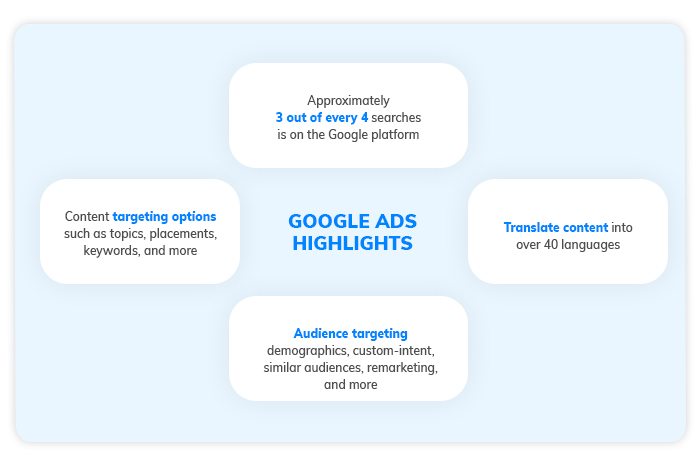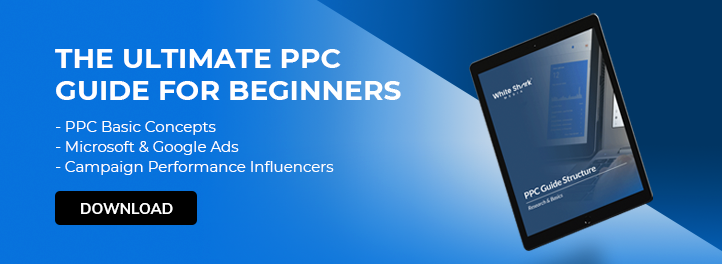[display-name-category]
[post_author]
[wtr-time]
As consumer behavior migrates online, PPC campaigns, management, and tools will increase in importance. If it wasn’t part of your strategy before, it’s most likely made its way to the discussion.
That said, before you start setting up your Google Ads or Microsoft Advertising campaign, it’s vital to get your PPC feet wet. That way, the array of features and settings that you find on these platforms will be exciting -and not overwhelming- as you begin.
Let’s start at the beginning. If you wonder what PPC is and what is not, we’ll review these in the post below.
What is PPC?
Pay-per-click or PPC is an advertising model in which you pay only for the clicks your ads receive. This form of advertising is most common on search platforms like Google or Bing, but you’ll also see them on websites that you probably visit several times a day.
Keywords used in search queries trigger ads. As an advertiser, you can choose which keywords will pull your ads. In short, each advertiser makes a claim, “I want my ad to show up whenever someone types in the word ‘plumber’ in Google,” and the platform evaluates to see if this request is useful to the user in search of information, products or services.
What PPC Is Not
PPC Isn’t SEO
SEO stands for Search Engine Optimization, a marketing tactic used to increase the amount and quality of traffic to a website from unpaid or “organic” search engine results. With content written around the right keywords, Google knows what your website is about and will show it to people searching for you- for free!
PPC Isn’t SEM
SEM stands for Search Engine Marketing and describes any type of marketing in search engines. It refers to all the actions that serve to position a product in potential customers’ minds to obtain something in return.

So, it’s easiest to think of SEM as the combination of SEO, SMO, and PPC. Together, these three advertising strategies help you position your brand online.
Of the search engines available, there are two dominating the market and will be instrumental to your campaigns due to their reach and their useful features.
How PPC Advertising Works?

The Google and Microsoft platforms offer placements on a wide range of pages within their network where strategists aim to get featured.
For example, depending on your campaign goals, your ad can run on the Search Network. This network would create ads made up of captivating text and a solid CTA.
If your goal leads you to the Display Network, your ad format may use images as the main item to capture users with an added CTA to seal the deal. Once either of these ads is clicked on, the advertiser pays a fee to the platform.
All of the PPC settings and features available to advertisers are important because they allow businesses to reach their target audience in an optimal format at a set budget.
Moreover, PPC campaigns help increase awareness of products and services even if no one clicks on your ad.
What are Google Ads?
Google is where people search for what to do, where to go, and what to buy.
Your digital ads can appear on Google at the very moment someone is looking for a product or service like yours. Whether they’re on a TV display, tablet, desktop, or on their phone, a well-timed ad can turn a user into a valuable customer.

Learn more about spending on Google Adwords.
What is Microsoft Advertising?
Microsoft Advertising (formerly Bing Ads) is a service that provides pay-per-click advertising on Bing and Yahoo! search engines.
Did you know? People use Microsoft more they realize. Microsoft is the default search engine for Safari on all apple devices, The Wall Street Journal website, and more commonly used sources.
Like Google Ads, Microsoft Advertising auctions ad placements to the maximum amount they are willing to pay per click (PPC) to relevant advertisers. Several indicators, such as click-through rate (CTR), help determine how frequently an advertisement is featured.
Highlights Include:
- Access to LinkedIn Profile Targeting, which allows smarter segmenting. For example, the ability to focus on LinkedIn members by college students, graduates, or professionals from a specific industry or company.
- Less competitive platform; it has a lower cost per click and cost per acquisition.
- Microsoft Ads allows you to target users based on a wide range of options on the ad group level, such as geographic location, day of the week, device, demographics, and more.
For more on the basics of Microsoft Advertising, read this blog!
What Influences PPC Performance?
There are many contributing factors to a successful PPC campaign. Whether your ads are on Google Ads or Microsoft Advertising, the set up of your campaigns and PPC ads will have to be done carefully to avoid any misdirection.
Though it may seem overwhelming, once you understand a few essential terms and how they influence your campaign’s performance, you start to understand what needs to be done to market your business.
CTR
A click-through rate can gauge how well your keywords and ads are performing. CTR represents the ratio of people who see your ads and who click on it.
Your CTR is the number of clicks that your ad receives divided by the number of times your ad is shown: clicks ÷ impressions = CTR. For example, if your campaign has:
- Five clicks
- 100 impressions
- CTR is 5%
CPA
CPA is the cost per acquisition of your campaigns. At the same time, this KPI indicates the ROI of your pay per click advertising. Therefore, decreasing CPA is an objective every marketer keeps in mind while working on their strategy.
Even though CPAs vary per industry, there are common tactics you can implement to improve this number.
Conversions and Conversion Rate
When someone interacts with your ad, that action is considered a conversion. You’ve defined what that action is in the set up of the ad. For example, you could have set the conversion as a click on a text ad or a view of a video ad. It will be deemed valuable by your business, whether it’s an online purchase or a call to set up an appointment.
Conversion rates are calculated by taking the number of conversions and dividing that by the number of total ad interactions during the same period.
For example, if you had 50 conversions from 1,000 interactions, your conversion rate would be 5%, since 50 ÷ 1,000 = 5%.
Learn more about conversion-focused campaigns.
Keywords and Negative Keywords
When a person uses your keyword on Google or Bing, your ad becomes eligible to be featured. Whether you are selected will depend on your keywords’ similarity to the person’s search terms and keyword match types. They are also used to match your ad to relevant sites in the Google Network.
Quality Score
Quality Score is Google’s rating of the quality and relevance of your keywords and PPC ads. This number will contribute to your cost-per-click (CPC) and weighs in the ad auction process. Similar to how credit scores help dictate eligibility, Google uses this to qualify you for placement and how much you should pay for each click.

Understanding and learning to manage your Quality Score is a part of mastering PPC. It has enormous influence over the cost and effectiveness of your paid search campaigns.
Why Do Businesses Outsource PPC?
As you can tell, PPC marketing has many moving parts – enough to seem daunting to anyone without a lot of experience with it.
This is why it is so common for companies to outsource their PPC advertising to experts.
As the digital world is continually evolving, PPC requires constant monitoring. Managing ad campaigns and all the elements that influence your PPC ads demand continuous coverage and tools to manage PPC successfully. Outsourcing PPC works for many agencies and businesses because of three main benefits:
- Cost: Add PPC management services to their portfolio without investing in training, new equipment, and tools.
- Speed: Improve turnaround time as they consult the agency’s expertise and experience.
- Custom Materials: Request customized presentations and receive recommendations on optimizations.
In short, PPC is a powerful way for businesses to advertise their products and services, but if it’s mishandled, it can be costly and time-consuming. Hiring a white label pay-per-click advertising company can help
make it possible to add it to your services portfolio or digital strategy.
The most important thing to consider with PPC is making sure that your investment is providing quality service. No one needs to burn through a budget without reaching their desired audience. That’s not what PPC is for.
Are you interested in learning more about our white label services? Contact us!
Conclusion
In a nutshell, PPC is a form of advertising used to drive traffic to websites. Displaying ads on search engines, content sites, and social networks can significantly impact any business.
As you’ve learned in the post above, there are many moving parts to making sure PPC campaigns run smoothly, but with the right guide and sources, it is not impossible to employ this form of digital marketing.
Want to learn more? Download our ebook!





